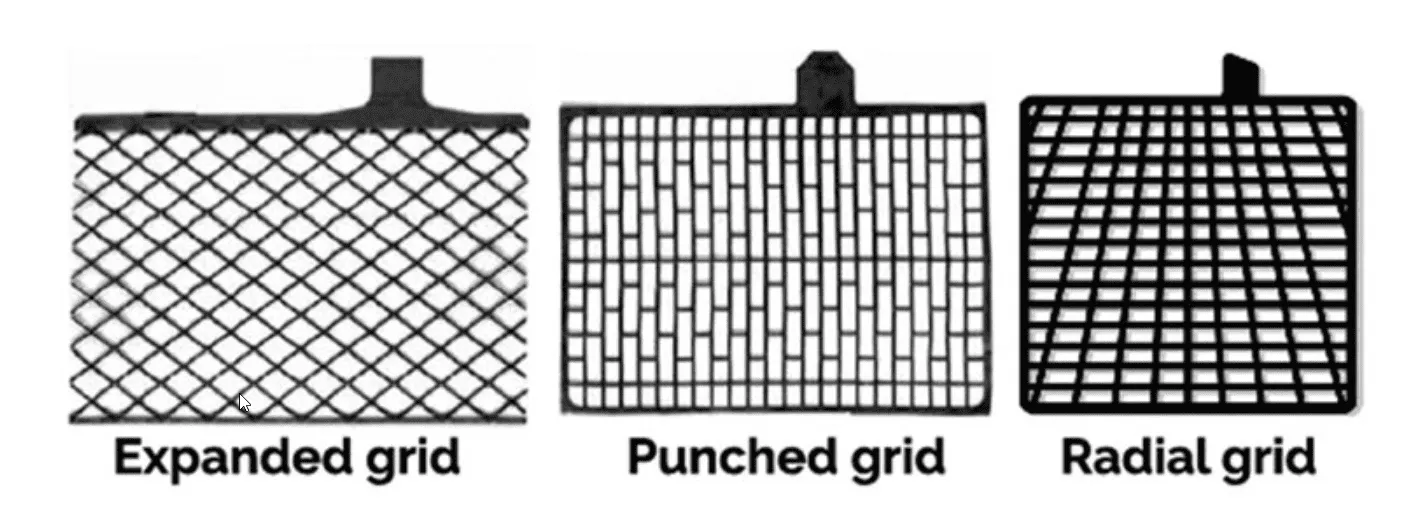Why Battery Grids Matter
In the world of lead-acid batteries, the grid is a silent workhorse. Often unseen by end-users, this essential framework not only holds the active material in place but also serves as the main pathway for electrical current. Without a strong, well-designed grid, even the most advanced battery chemistry cannot perform reliably.
At SUZUKI Battery, we engineer grids to withstand extreme temperatures, heavy cycling, and demanding power requirements — from cold winter starts to the relentless heat of tropical climates. This article explores the function, design, and challenges of battery grids, with a focus on how material advancements are improving battery life and efficiency.
1. Function of the Battery Grid
The grid in a lead-acid battery is typically made from a lead-alloy framework, performing two critical functions:
- Structural Support
The grid secures the active material — lead dioxide (PbO₂) for positive plates and sponge lead (Pb) for negative plates — maintaining plate integrity during charge and discharge cycles. This prevents shedding of active material, a common cause of capacity loss. - Electrical Conduction
The grid acts as a highly conductive network, moving electrons from the plates to the terminals and enabling power delivery. In automotive batteries, this supports high Cold Cranking Amp (CCA) ratings — often between 400 and 800 CCA — ensuring dependable engine starts and accessory power.
A well-designed grid is essential for maintaining consistent performance, particularly in high-demand applications like start-stop systems, industrial equipment, and renewable energy storage.
2. Grid Materials and Design
Grids must balance strength, conductivity, corrosion resistance, and weight. This balance is achieved through material selection and modern design optimisation:
- Common Alloys
Lead-calcium alloys reduce water loss and extend service intervals, while lead-antimony alloys improve mechanical strength but require more maintenance. - Design Features
Modern grids are thinner (~0.8–1.5 mm) yet stronger, often using precision lattice patterns to maximise surface area. This boosts both power output and recharge efficiency, critical for short-distance driving and frequent start cycles. - Material Advancements
Corrosion-resistant additives such as tin improve conductivity and extend service life. Emerging nanostructured grid designs distribute stress more evenly, improving resistance to cracking and thermal damage.
These innovations mean that modern grids can last 3–5 years in automotive use — and even longer in well-maintained deep-cycle applications.

3. Challenges and Failure Factors
Despite technological advances, grids face several degradation risks:
- High Temperatures
Sustained heat exposure (50–75°C) accelerates corrosion, weakening grids and reducing battery capacity. In hot climates, this can shorten battery life by 20–30%. - Cold Weather
At extreme low temperatures (e.g., -30°C), grids must deliver maximum current. If weakened by prior corrosion, they may fail to produce sufficient starting power . - Overcharging
Excessive charging promotes grid oxidation and distortion, further reducing conductivity. This is especially harmful in vehicles with poorly regulated charging systems.
Modern grid technologies counter these problems with alloy formulations that resist corrosion, improved cooling designs, and protective coatings that extend operational life in extreme driving environments.
FAQs About Battery Grids
Conclusion: Choosing the Right Battery Grid for Longevity and Performance
The grid may be hidden inside your battery, but its role is critical. It not only keeps the active materials in place but also serves as the backbone of electrical conduction. Advances in alloy composition, structural design, and corrosion prevention have made modern grids far more resilient to heat, cold, and high cycling demands.
For drivers in extreme climates, fleet operators, or anyone seeking maximum battery life, selecting a battery with an advanced grid design can make the difference between consistent performance and frequent replacements. At SUZUKI Battery, we integrate these cutting-edge grid technologies into every product, ensuring reliability mile after mile.
References:
1. Jung, J., Zhang, L., & Zhang, J. (Eds.). (2015). Lead‑Acid Battery Technologies: Fundamentals, Materials, and Applications. CRC Press.ISBN-13: 978-1466592223
2. Pavlov, D. (2011). Lead–Acid Batteries: Science and Technology. Elsevier.
ISBN: 9780444528827

